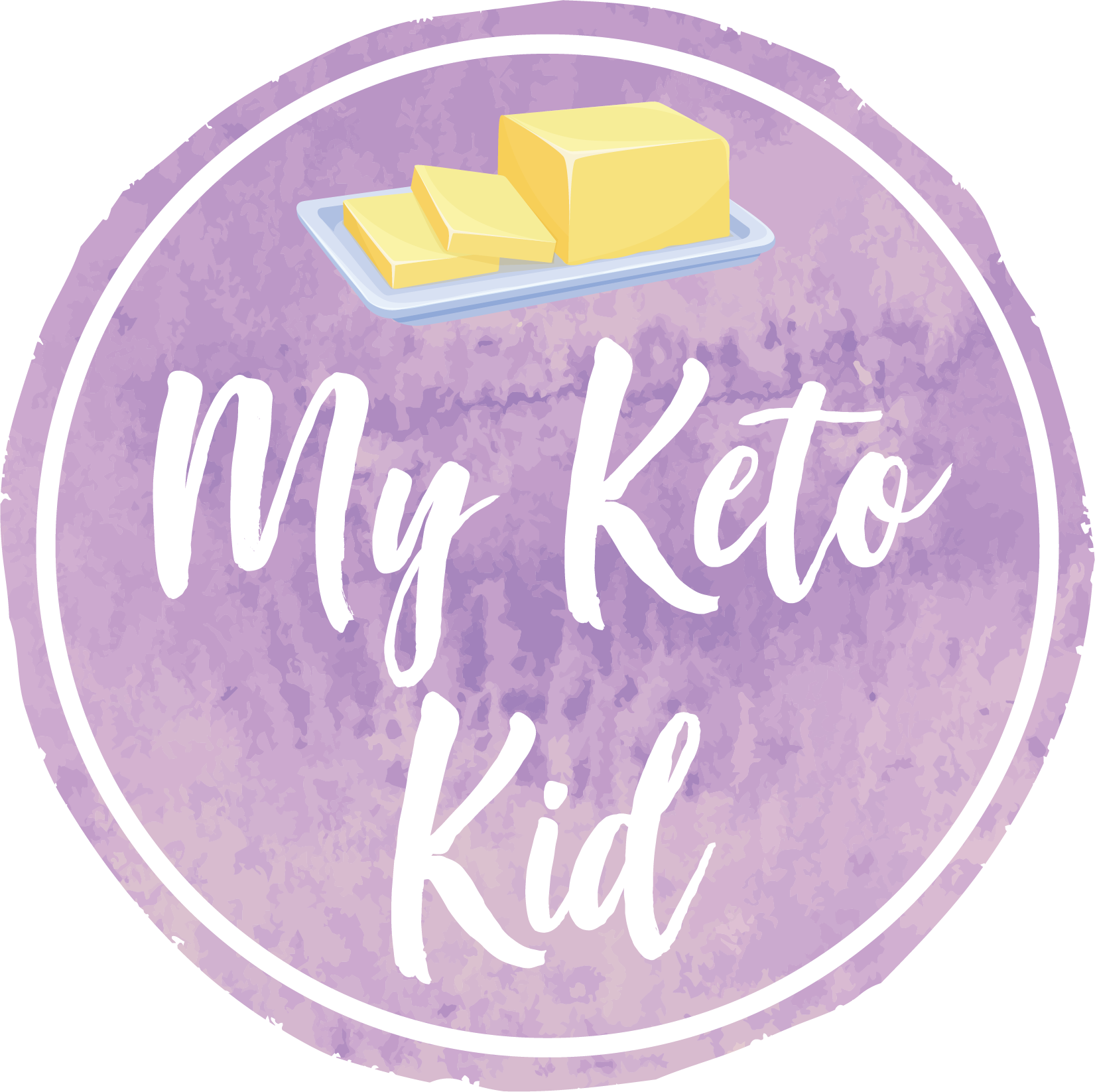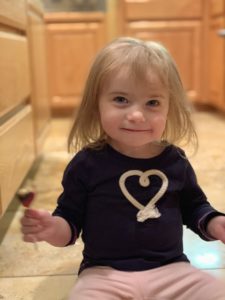
Until she was 1 1/2, Reese was pretty normal. The last 30 minutes of her birth were a little rocky, so she spent 3 days in the NICU for monitoring. Other than that, she was a wonderful and easy going little girl. Curious, always happy, and practically sleeping through the night since birth! She hit nearly all of her motor milestones early and knew about 40 ASL signs, so she was communicating pretty well, although she wasn’t talking quite as much as we would have liked.
February 2018
When my son was due any day, Reese started to have these weird twitches where her arms would fling out to the sides about shoulder height and her head would jerk down a little. Very brief. At first, it was once a day, and being her primary care taker, I was the only one who saw them. After a while, they became more frequent and my husband, Matt, noticed them. A few weeks after that, anyone who spent a substantial amount of time with us noticed them.
Nicholas, born in late February, was born with a skull condition called craniosynostosis where the bones in his head had fused prematurely, forcing his head to grow unusually long and narrow. Left untreated, it could cause developmental delays, blurred vision, and lifelong headaches. In the first few months, this issue consumed our lives. Reese’s seemingly mild twitches were put on the back burner while my son prepared for, had, and recovered from skull surgery.
By July, the twitches were happening about 6 times a day and we had already been to the pediatrician and told it was probably just her body sort of figuring itself out, but we got a referral to see a neurologist. There wasn’t any pattern with the timing – just spaced out throughout the day, in clusters of 3-4 in the beginning.
August 2018
In late August, she had a longer one of these twitches, immediately rolled over, and slept for 2 hours. She was never a napper and this seemed weird to us. Even though our first appointment with the neurologist was just a week away, we called her office. They said if we were uneasy, to go to the ER downtown. They had a pediatric neurologist on staff at that location. We did and were just about to be sent home, when almost on cue in the short time the ER doctor was in the room to speak with us, Reese twitched. It was enough to admit us overnight. The next day, when the pediatric neurologist saw us and we were about to start a 30 minute EEG, again on cue, she did it. So the neurologist decided to do a 24 hour EEG with video monitoring. She had about 9 twitches that day. They did an MRI and it was normal. After looking at the data from the EEG, we were sent home and told to be cautiously optimistic about things and to keep our appointment for later in the week with the neurologist that we’d been waiting months to see. I asked the doctor if there was a magic jelly bean I could give Reese to cure whatever it was. No luck.
When we met with the neurologist, she told us that Reese had epilepsy – her twitches were myoclonic seizures. Again, I asked for a magic jelly bean, but instead Reese was put on Keppra. I’m a little on the crunchy side and so I hated having to put her on medicine. Anti epileptic medicines are not something to joke about. But always the optimist, I hoped that maybe we could be on the lowest dose, stay on it for a few years, wean off it, never have another seizure, and get out of this whole thing unscathed. Over the next several months, the medicine would seem to help for a couple days and then stop being as effective. We’d up the dose, it’d help a little, then stop being effective. At best, we were down to about 4 seizures a day and they were a little less intense in that her arms wouldn’t fling up as high. The clusters mostly went away. In November, when we’d maxed out the Keppra, we added in Topamax. That didn’t seem to work much better either. But Reese had turned into a rock star at taking meds.
Meanwhile, we continued trying to keep Reese’s life normal. She was in swim lessons and, although she cried the whole time, her instructor said she was a great swimmer – she was fearless (so it was good we were being proactive about pool safety at a young age!) and she had 4 year old students who weren’t as good at swimming. She had been in gymnastics once a week since she was 5 months old and always very much enjoyed it. She loved all the activities and being with kids her age. She loved the songs, jumping on the trampoline, and playing with the parachute. Reese definitely wasn’t losing any ability to talk, but we felt her speech delay was becoming more apparent. We mentioned it to every medical professional we came across, but it seemed that her saving grace was that she knew so many signs. She was learning new words, but very slowly… maybe one or two words a month. We got her into speech therapy but it didn’t seem to work the wonders we had hoped for, but again, she was improving.
December 2018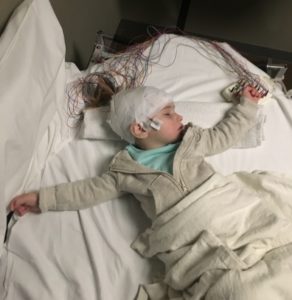
In late November, we did a routine 30 minute follow up EEG. A couple days later, the neurologist called us and wanted us to come in. We had a trip to Disneyland planned that week, so I asked if we should cancel the trip. They said no, but to come in the day we returned home. That didn’t seem like a good sign, so my whole Disneyland trip had a cloud over it. I tried to just enjoy the moment, knowing there could be bad news ahead. We returned home on the 6th and had our appointment on the morning of December 7th. We were told that Reese’s EEG was very unusual. It looked similar to hypsarrhythmia – a type of brain activity strongly linked to developmental regression. She had epileptic encephalopathy. Her brain was failing her. Reese didn’t fit any diagnosis exactly, but it was like we were between Infantile Spasms (catching it late) or Lennox-Gastaut (catching it early). Both are awful. No magic jelly bean for either. We were told that there was a substantial chance that Reese wouldn’t develop past where she was now, and could start to regress. It felt like we were supposed to go home and just wait for the inevitable.
 That evening, we had plans to pick out a Christmas tree with my parents who had just moved to the area. Matt and I didn’t feel like doing much of anything. We wanted to just stay home and feel sorry for ourselves. Quickly, we changed our minds. We decided that if by this time next year, Reese had lost the ability to walk, we wanted her to have walked through the Christmas tree lot this year. We wanted to make memories, take fun photos, and enjoy every moment we got. No matter what the future held for us, we didn’t want to change anything or feel sorry for ourselves. We’d just be happy with what we got, whatever that was.
That evening, we had plans to pick out a Christmas tree with my parents who had just moved to the area. Matt and I didn’t feel like doing much of anything. We wanted to just stay home and feel sorry for ourselves. Quickly, we changed our minds. We decided that if by this time next year, Reese had lost the ability to walk, we wanted her to have walked through the Christmas tree lot this year. We wanted to make memories, take fun photos, and enjoy every moment we got. No matter what the future held for us, we didn’t want to change anything or feel sorry for ourselves. We’d just be happy with what we got, whatever that was.
We decided that, as my mom likes to say, we would just keep redefining normal until we got there.
But still, I felt desperate and decided to try Jayden’s Juice CBD oil. I gave Reese a couple of very low doses and I felt it helped. I had also considered the ketogenic diet, and would mention it at every doctor’s appointment, but was told that it was too hard and “we weren’t there yet.” At every single visit, I asked.
Because of the recent EEG, the neurologist wanted to put Reese on a strong steroid, hoping to at least preserve the brain function she currently had. I mentioned that we had given Reese CBD oil and I felt it had helped. The month prior, Epidiolex (the FDA cleared CBD oil) had just been approved for children with catastrophic forms of epilepsy and she wrote us a prescription, knowing it would take some time to get approved through insurance. We agreed not to use the CBD oil (ours or the prescription one) until after the round of steroids, but to at least get the process started. The steroid (a high dose prednisone) would effectively wipe out her immune system and so we needed to essentially be on quarantine. We mentioned she had recently gotten an infected tooth that she was on antibiotics for while we waited to be seen by a dental surgeon to have it removed. That stopped our plans to start the steroid dead in its tracks. We couldn’t do anything until the infected tooth was resolved. Removing the infected tooth (it had a chip that started small and got larger over time – our neurologist suspected it could have been caused by her teeth crashing together during her seizures), we were told, would require general anesthesia coordinated with the hospital since Reese was so young and couldn’t hold still for the procedure. When could Reese get a break?! Suddenly, getting this tooth pulled became even more urgent. Somehow, we got lucky – I got an appointment to be seen that Monday and during the appointment, the oral surgeon asked if Reese was any good at taking medicine. Boy, was she! I guess that’s the upside of taking so much medicine. I explained our situation and with a little convincing (and seeing that she was good at taking medicine and fairly relaxed) he said he was willing to try to pull it. Success! Tooth out that day, no general anesthesia, no waiting for weeks to coordinate with the hospital!
Two days later, we were back in the neurologists office getting set up on the prednisone. I decided to start logging everything – seizures, what she ate, the medicines she was taking and when, and anything else that seemed important for that day. The timing to start all this wasn’t great – this meant we wouldn’t be able to celebrate Christmas with either of our families. But you do what you have to do, right? Thank goodness for Amazon Prime and supportive family members who did our grocery shopping and anything else we asked of them. After a few days of prednisone, she had her first seizure free day since February. It felt amazing! A normal life flashed in front of my eyes. Unfortunately, a day or two later, the seizures came back. We went back to the neurologist’s office on December 27. This wasn’t working, and she decided to admit us into the hospital across the street. It was a little shocking, as we thought this was just going to be a routine doctor visit.
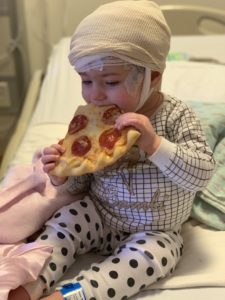 We got admitted and started on a continuous EEG with video monitoring. We then met the doctor who would become our new neurologist, Dr. C. He quickly decided that clearly the Keppra, Topamax, and prednisone weren’t working. He decided to start her on ACTH. We also started Depakote, Onfi, and briefly tried Felbamate. I hated all these meds, but was much more comfortable trying them while hooked up to the EEG machine so that we could quickly see whether or not they were working and adjust accordingly. Better than being on Keppra for over 3 months with no great results to show. Within a day or two, with a constant tweaking of meds from our new neurologist, who I’m convinced doesn’t sleep, we had no more myoclonics, but instead had tonic seizures as she was drifting off to sleep and sometimes a few during the wake transition. But during the day, she didn’t have any seizures.
We got admitted and started on a continuous EEG with video monitoring. We then met the doctor who would become our new neurologist, Dr. C. He quickly decided that clearly the Keppra, Topamax, and prednisone weren’t working. He decided to start her on ACTH. We also started Depakote, Onfi, and briefly tried Felbamate. I hated all these meds, but was much more comfortable trying them while hooked up to the EEG machine so that we could quickly see whether or not they were working and adjust accordingly. Better than being on Keppra for over 3 months with no great results to show. Within a day or two, with a constant tweaking of meds from our new neurologist, who I’m convinced doesn’t sleep, we had no more myoclonics, but instead had tonic seizures as she was drifting off to sleep and sometimes a few during the wake transition. But during the day, she didn’t have any seizures.
Dr. C said overall things were looking better on her EEG. The seizures looked so much worse to us and there were so many more of them when they came (one day, I counted 100, and I know I missed some despite my best efforts). But she was so much more alert and alive. She said “kiss” and wanted to give everyone kisses. For the first time, she was giggling – she had laughed a lot before, but in hindsight we realized she never really giggled… it was magical. She was dancing to the music on the TV. She had a twinkle in her eye again. So we believed what Dr. C said when he said things were improving, even though I started to loathe and fear the sleep transition.
On one of our phone calls, he mentioned the Ketogenic Diet and I jumped on that – I asked if we could start. He said it was hard and our hospital doesn’t typically do hospital starts anymore, but if I was up for it, we could try. I wanted to try anything! I confidently said I was up to the challenge. He put in the orders immediately and just like that we started. We immediately cleared the room of any carbs (Reese was a picky and light eater. We practically gave her anything because at least it was something. I’m not proud about it. Also, we’d been bribing her with Rice Krispy treat minis to get us through the hospital procedures). Timing couldn’t have been worse since it was New Years Day and a lot of the specialists had the day off, but I didn’t care.
I’m not going to lie, the first few days were rough. Especially the first half day. My mother in law’s love language is food and she was visiting that evening. The steroids had been making Reese ravenous for several days and she was finally asking for food, which my mother in law was elated about. And we had to say no to basically everything she wanted. It was heartbreaking. She was so hungry because of the steroids that she had gone from 23 pounds (2nd percentile) to nearly 30 pounds (55th percentile) in a month. Sugar free Jello got us through, and was how we gave her meds (all now sprinkles or crushed up tablets – no more of the sugary liquid suspensions that Reese was accustomed to and good at taking). In the hospital, we really were just doing a low carbohydrate diet. I began to research what the ketogenic diet for epilepsy truly entailed. I knew we weren’t doing enough fat with the meals the hospital provided. I was given a brief overview of what this diet would entail by a dietician, but told that there was a dietician who was an expert with the ketogenic diet for epilepsy who was off for the holiday. Everyone in the hospital spoke so highly of this dietician for the ketogenic diet, so I knew we would be in good hands soon enough. She even called on her day off to get us going in the right direction. We were motivated. We’d try anything to stop these seizures.
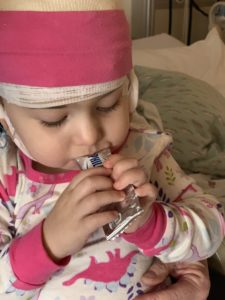 My parents came to visit daily during our 10 day hospital stay so that I could get coffee and gather my thoughts. When I was getting coffee one day, I noticed a cream cheese packet. I used my new knowledge and calculated that it had a 3.5:1 ratio. Pretty decent. I asked to buy it – they were a little surprised since I wanted it without the bagel. They didn’t even know how to charge for it, so they just gave it to me. I gave it to my daughter and she ate it like it was a yogurt tube. She loved it. We bought more cream cheese. It seemed like her seizures were lessening in length and intensity.
My parents came to visit daily during our 10 day hospital stay so that I could get coffee and gather my thoughts. When I was getting coffee one day, I noticed a cream cheese packet. I used my new knowledge and calculated that it had a 3.5:1 ratio. Pretty decent. I asked to buy it – they were a little surprised since I wanted it without the bagel. They didn’t even know how to charge for it, so they just gave it to me. I gave it to my daughter and she ate it like it was a yogurt tube. She loved it. We bought more cream cheese. It seemed like her seizures were lessening in length and intensity.
It wasn’t until we were discharged on January 6 that I could really pack in the fat like I wanted. Once home, we were on the keto diet (or as best I could do with the information I found online). To be honest, I think I did pretty darn well! And in the first few days of being low carb and then to keto, her seizures went from 100, to 40, 20, 12, 0. Must have been a fluke. But another day went by with 0 seizures, then another. I figured it wouldn’t last, just like with the honeymoon effect that the meds had, but before we knew it, we celebrated 1 week seizure free! After 10 days of being seizure free, while going to bed, Reese had 3 breakthrough seizures. They lasted 30-45 seconds – easily her longest. She had a couple more shorter ones during nap time 2 days later. The next day, we finally got Epidiolex cleared through insurance and got started on it. Tough to say what made the difference or why she had a hand full of breakthrough seizures. Some things, we’ll probably never know, but we got a little stricter with the Ketogenic Diet.
I was told this diet was hard. It certainly isn’t effortless, but a little planning and measuring meals isn’t hard. Watching your child have countless seizures everyday is hard.
As I write this, we’re going on 1 month seizure free. Reese has taught me so much these past few months. She’s strong, stubborn, resilient, and brave.
My goal is seizure freedom and I will continually strive for that. But if Reese had a seizure tonight, this diet would still be worth it. Any time her brain gets to rest makes everything worthwhile.
Moral of the Story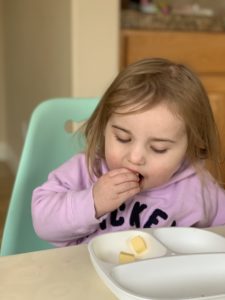
I asked for a magic jelly bean but got a magic butter ball. And I’ll take it. I’m getting my daughter back.

